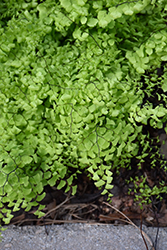It's all about ...
plants

Bermuda Run Southern Maidenhair Fern
Adiantum capillus-veneris 'Bermuda Run'
Height: 10 inches
Spread: 3 feet
Sunlight:
![]()
![]()
Hardiness Zone: (annual)
Other Names: Black Maidenhair Fern, Venus Hair Fern
Description:
This compact variety is one of the most beautiful of our native ferns; bright green pinnae held along arching black stems, becoming horizontal and layered; a lovely addition to the shade garden; tolerates deep shade
Ornamental Features
Bermuda Run Southern Maidenhair Fern is primarily valued in the garden for its cascading habit of growth. Its fan-shaped pinnately compound leaves are light green in colour. As an added bonus, the foliage turns a gorgeous gold in the fall. The black stems are very colorful and add to the overall interest of the plant.
Landscape Attributes
Bermuda Run Southern Maidenhair Fern is an herbaceous annual with a shapely form and gracefully arching foliage. It brings an extremely fine and delicate texture to the garden composition and should be used to full effect.
This is a relatively low maintenance plant, and usually looks its best without pruning, although it will tolerate pruning. Deer don't particularly care for this plant and will usually leave it alone in favor of tastier treats. It has no significant negative characteristics.
Bermuda Run Southern Maidenhair Fern is recommended for the following landscape applications;
- Mass Planting
- Rock/Alpine Gardens
- General Garden Use
- Groundcover
- Naturalizing And Woodland Gardens
Planting & Growing
Bermuda Run Southern Maidenhair Fern will grow to be about 10 inches tall at maturity, with a spread of 3 feet. Its foliage tends to remain low and dense right to the ground. Although it's not a true annual, this slow-growing plant can be expected to behave as an annual in our climate if left outdoors over the winter, usually needing replacement the following year. As such, gardeners should take into consideration that it will perform differently than it would in its native habitat.
This plant does best in partial shade to shade. It prefers to grow in moist to wet soil, and will even tolerate some standing water. It is particular about its soil conditions, with a strong preference for rich, alkaline soils. It is highly tolerant of urban pollution and will even thrive in inner city environments, and will benefit from being planted in a relatively sheltered location. Consider applying a thick mulch around the root zone over the growing season to conserve soil moisture. This is a selection of a native North American species, and parts of it are known to be toxic to humans and animals, so care should be exercised in planting it around children and pets. It can be propagated by division; however, as a cultivated variety, be aware that it may be subject to certain restrictions or prohibitions on propagation.
